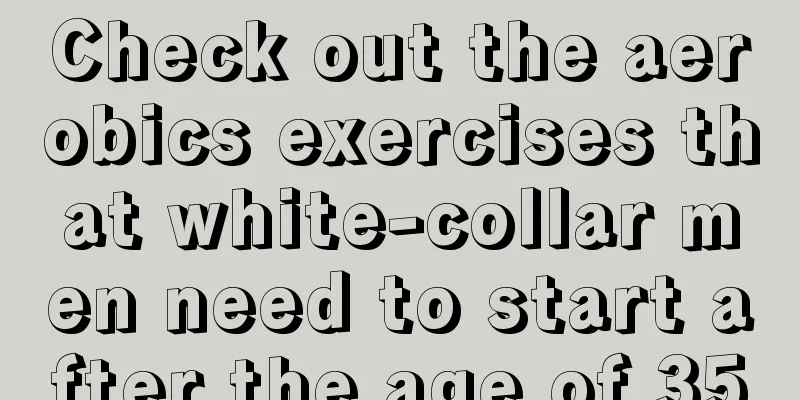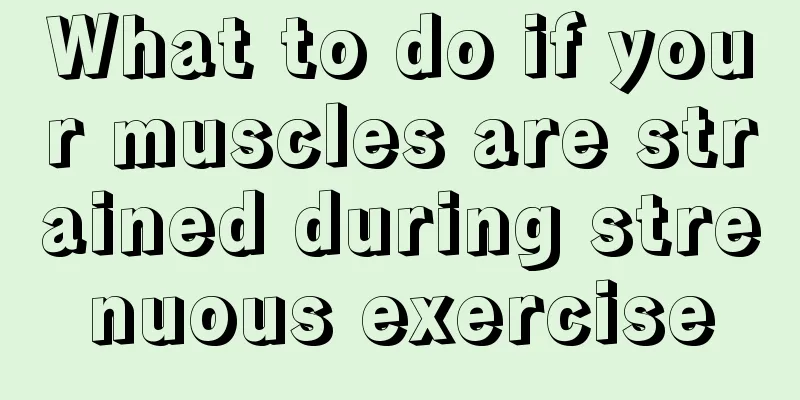Check out the aerobics exercises that white-collar men need to start after the age of 35

|
For men, they are in their prime years and aging seems to be a long way off. However, this age group is also the transition period for men from youth to middle age, and their physiological skills have shown subtle signs of decline, such as decreased physical strength, weakened muscle strength, and reduced lung ventilation. Therefore, men should increase their exercise in a targeted manner starting from the age of 35. Prescription 1: Abdominal tightening and leg lifting Exercise method: Lie on your back on an incline board with your arms straight, hold the support behind your head with both hands, keep your upper body still, and stretch your legs upward to do abdominal contraction and leg lift exercises. Bring your legs as close to your chest as possible and then put them down, then lift them up again, and repeat this process. Requirements: The angle at which the inclined board is fixed can be determined based on your physical condition. For example, if your waist and abdomen are strong, the slope of the inclined board can be larger; if your strength is weak, the slope can be smaller. When you tighten your abdomen and lift your legs, keep your legs straight; do not bend your knees; when lowering your legs, slow down the speed to stretch your abdominal muscles; do 10-15 times in one set, rest for 1-2 minutes after finishing, and then do the next set of exercises. You can do 2-3 sets. Do it 2-3 times a week. Function: Improve waist and abdominal muscle strength, expand chest, and enhance respiratory function. Prescription 2: Supine two-end raise Exercise method: Lie flat on the floor or bed, with your legs together and stretched naturally, and your arms stretched naturally behind your head. When sitting up, lift both legs and arms up and press down at the same time, move them closer to the middle of the body, fold the body in half with the hips as the axis, then return to the original shape, and continue to do the exercise of raising both ends. Do it continuously for 10-15 times, 2-3 sets each time, and exercise 3-5 times a week. You can use it as an auxiliary exercise after getting up in the morning or after doing other exercises. Requirements: When doing sit-ups, your limbs should be naturally straightened, do not bend your knees, and move at the same time, not in order; inhale when doing sit-ups, and exhale when putting your legs down, do not hold your breath intentionally; when you first practice, your coordination may be poor, and your hands and feet cannot be raised at the same time or the folded angle is small (hands and feet cannot touch each other). That's okay, the movement will be perfected over time. Function: Increase waist and abdominal strength and improve body coordination. Prescription 3: Weighted Kicks Practice method: 1. Stand upright with one leg supporting the body (those with weak constitution can hold on to something), tie a sandbag or other heavy object to the other calf, and do a forward kick. The height of the kick should form a right angle with the upper body. After kicking 5-10 times, switch to the other leg and continue. 2. The preparatory action is the same as method 1, but instead of kicking forward, kick to the side of the body. The wider the kick to the side, the better. After kicking 5-10 times, switch to the other leg and kick 3 times each. 3. Slightly different from the above method: instead of kicking, it is flexion and extension. The specific method is to sit on a high stool, hook dumbbells with your feet or hang other heavy objects or tie sandbags to your calves, naturally slightly hunch your upper body, hold your hands on both sides of the high stool, let the non-weight-bearing leg hang naturally, and do flexion and extension exercises on the weight-bearing leg. After 10 flexion and extensions, switch to the other leg, and exchange the two legs 3-4 times. Requirements: When doing front kick and side kick, keep your legs straight, do not bend your knees, and keep your upper body still; when doing high bench flexion and extension, keep your upper body still and use the knee joint as the axis for flexion and extension exercises. Function: Mainly develops the strength of the calf and thigh quadriceps. |
<<: Dumbbell fitness plan for building muscle at home
>>: 7 ways to walk to lose weight in different parts of your body
Recommend
Can simulated skipping lose weight?
Simulated rope skipping is an exercise that many ...
How to recover after climbing a mountain?
Although mountain climbing is a very enjoyable th...
How to do yoga to regulate irregular menstruation?
In daily life, eating habits and living habits ma...
What are the elementary yoga poses?
Yoga is now a very popular sport. Many people lik...
Can running reduce thigh fat?
I don’t know if you have ever heard this joke: Wh...
How to practice Taekwondo
Taekwondo is a very good way to exercise. Nowaday...
How to warm up before exercise?
Many people don't know how to warm up before ...
What are the benefits of women practicing yoga regularly?
Nowadays, many girls hope to have a better figure...
How to stick to exercise
Many people want to exercise, but they give up af...
How much running is better for losing weight?
The hot summer is here, and many people are not s...
How to exercise running correctly?
People in this era pay great attention to health,...
How can I keep my calves from getting thicker when running?
Running can exercise the body and is also particu...
What is Body Shaping Yoga
When it comes to body shaping yoga, everyone can ...
7 ways to easily “walk” out of longevity! Everyone can do it
I am used to driving, taking the bus or subway to...
What are the functions of tennis?
Some people like sports because they really like ...









